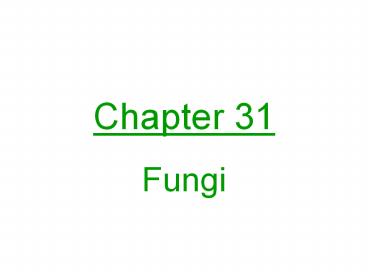Fungi - PowerPoint PPT Presentation
1 / 41
Title: Fungi
1
Chapter 31
- Fungi
2
Characteristics
- eukaryotic
- mostly multicellular, yeasts unicellular
- no locomotion
- sexual asexual reproduction in most
- heterotrophic by absorption (digestion
extracellular) - gt 100,000 species
- saprophytes (also parasites, mutualistic
symbionts) - some pathogenic
- decomposers
- classified by sexual reproduction
- cell walls of chitin (polysaccharide)
3
Structure
- hyphae rootlike structures for absorption
- which collectively form a network, mycelium
- cell walls
- septate with cross walls with large pores
- aseptate(coenocytic)no cross walls
multinucleate - haustoria nutrient-absorbing threads that
- penetrate tissues of host in some parasitic
types - hyphae may grow as fast as 1km/day
- mycelia have haploid nuclei, some dikaryons- 2
- separate nuclei that are dissimilar
4
Fungal mycelia
5
Cell wall types
6
Figure 31.2x Septate hyphae (left) and
nonseptate hyphae (right)
7
Haustoria
8
Reproduction
- spores (usu. haploid), diploid in brief sexual
reproductive cycles, then meiosis - returns these to haploid
- syngamy nuclear union in fertilization usu.
involves some form of conjugation - usu. asexually in optimal condtions, sexually in
harsh conditions
9
Generalized life cycle
10
Classification
- Division Zygomycota conjugation fungi
- -common molds, incl. Rhizopus stolonifer,
- Pilobilus
- 600 sp. mostly terrestrial in soil or on
- decaying plants/animals
- -coenocytic hyphae
- -asexually produce sporangia
- -sexually by zygosporangia formed during
- conjugation ( and strains fuse)
11
Zygomycete life cycle
12
Conjugation
13
Rhizopus
14
Pilobilus
15
- Division Ascomycota sac fungi
- 30,000 sp.
- -yeasts (Saccharomyces, Candida), Peziza
- (cup fungus), morels, Ceratocystis ulmi
- causes Dutch elm disease
- -septate hyphae
- -asexually by conidia on conidiophores
- -sexually by haploid ascospores in asci
- -most fungal symbionts in this group
16
Ascomycete life cycle
17
Peziza, truffle, morel
18
Yeast
19
Penicillium
20
apothecia
21
- Division Basidiomycota club fungi
- 25,000 sp.
- -mushrooms, puffballs, shelf fungi
- -produce gt 10 billion spores
- -septate hyphae
- -asexually none, or conidia in some
- -sexually by basidiospores in basidium
22
Basidiomycete life cycle
23
basidiomycetes
24
Gills of a basidiomycete
25
Stinkhorn, Phallis impudicus
26
Amanita (death cap)
27
Fairy ring
28
- Division Deuteromycota imperfect fungi
- 25,000 sp.
- -ringworm, athletes foot fungus, Arthrobotrys
- prey on roundworms in soil
- -asexually by conidia
- -sexually none observed
29
Symbioses
- 1) lichens algae (filamentous green)
- Chlorophyta or blue green (cyanobacteria)
- fungus (ascomycete)
- -may reproduce asexually either from
- fragments or by dispersing tiny airborne
- starters, soredia
30
Lichen structure
31
- each organism also reproduces either
- sexually or asexually
- alga provides food for fungus, fungus
- provides moisture, minerals, protection to
- alga perhaps
- thought to be more of a controlled
- parasitism, than mutualism
32
Lichens
- usu. given genus specific name
- 3 types
- a) crustose crusty
- b) foliose leafy
- c) fruticose shrubby
- air pollutant indicators
33
Crustose, fruticose, folliose lichens
34
Symbioses
- 2) mycorrhizae plant roots fungus
- -plant provides nutrients, fungus provides
- more surface area to absorb water
- -usu. basidiomycetes, may also be
- ascomycetes or zygomycetes
- found in 90 of tree species
35
Benefits of mycorrhizae
36
Mycorrhizae
37
Importance
- Beneficial
- decomposers
- food source
- source of antibiotics
- used in food and alcohol industries
38
Fungal production of an antibiotic
39
Importance
- Harmful
- decay products
- cause disease
- destroy crops
- spoil food
40
wheat rust, ergot on rye
41
pink ear disease of corn































